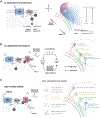Activity-dependent formation of the topographic map and the critical period in the development of mammalian olfactory system
- PMID: 38593162
- PMCID: PMC11003738
- DOI: 10.1002/dvg.23586
Activity-dependent formation of the topographic map and the critical period in the development of mammalian olfactory system
Abstract
Neural activity influences every aspect of nervous system development. In olfactory systems, sensory neurons expressing the same odorant receptor project their axons to stereotypically positioned glomeruli, forming a spatial map of odorant receptors in the olfactory bulb. As individual odors activate unique combinations of glomeruli, this map forms the basis for encoding olfactory information. The establishment of this stereotypical olfactory map requires coordinated regulation of axon guidance molecules instructed by spontaneous activity. Recent studies show that sensory experiences also modify innervation patterns in the olfactory bulb, especially during a critical period of the olfactory system development. This review examines evidence in the field to suggest potential mechanisms by which various aspects of neural activity regulate axon targeting. We also discuss the precise functions served by neural plasticity during the critical period.
Keywords: axon guidance; critical period; odor recognition; olfactory map; olfactory receptors (ORs); olfactory sensory neurons (OSNs); spontaneous activity.
© 2024 The Authors. genesis published by Wiley Periodicals LLC.
Conflict of interest statement
Conflict of interest statement:
These authors have no conflicts of interests.
Figures


Similar articles
-
In mice, discrete odors can selectively promote the neurogenesis of sensory neuron subtypes that they stimulate.Elife. 2025 Jun 18;13:RP96152. doi: 10.7554/eLife.96152. Elife. 2025. PMID: 40531183 Free PMC article.
-
Mex3a-dependent post-transcriptional silencing ensures olfactory receptor diversity and axon guidance specificity.Cell Rep. 2025 Aug 26;44(8):115979. doi: 10.1016/j.celrep.2025.115979. Epub 2025 Jul 15. Cell Rep. 2025. PMID: 40668674
-
Odor encoding by fine-timescale spike synchronization patterns in the olfactory bulb.J Neurophysiol. 2025 Jul 1;134(1):274-286. doi: 10.1152/jn.00340.2024. Epub 2025 Jun 14. J Neurophysiol. 2025. PMID: 40517018 Free PMC article.
-
Cell type-specific patterned neural activity instructs neural map formation in the mouse olfactory system.Neurosci Res. 2021 Sep;170:1-5. doi: 10.1016/j.neures.2020.06.007. Epub 2020 Jul 1. Neurosci Res. 2021. PMID: 32621834 Review.
-
Grouping and representation of odorant receptors in domains of the olfactory bulb sensory map.Microsc Res Tech. 2002 Aug 1;58(3):168-75. doi: 10.1002/jemt.10146. Microsc Res Tech. 2002. PMID: 12203695 Review.
Cited by
-
Olfactory Development and Dysfunction: Involvement of Microglia.Physiology (Bethesda). 2025 Mar 1;40(2):0. doi: 10.1152/physiol.00037.2024. Epub 2024 Nov 5. Physiology (Bethesda). 2025. PMID: 39499248 Free PMC article. Review.
References
-
- Aoki M, Takeuchi H, Nakashima A, Nishizumi H, Sakano H. 2013. Possible roles of Robo1+ ensheathing cells in guiding dorsal-zone olfactory sensory neurons in mouse. Dev Neurobiol 73: 828–840. - PubMed
-
- Axel R 2005. Scents and sensibility: a molecular logic of olfactory perception (Nobel lecture). Angew Chem Int Ed Engl 44: 6110–6127. - PubMed
-
- Bakalyar HA, Reed RR. 1990. Identification of a specialized adenylyl cyclase that may mediate odorant detection. Science 250: 1403–1406. - PubMed
-
- Barnea G, O’Donnell S, Mancia F, Sun X, Nemes A, Mendelsohn M, Axel R. 2004. Odorant receptors on axon termini in the brain. Science 304: 1468. - PubMed
-
- Belluscio L, Gold GH, Nemes A, Axel R. 1998. Mice deficient in G(olf) are anosmic. Neuron 20: 69–81. - PubMed
Publication types
MeSH terms
Substances
Grants and funding
LinkOut - more resources
Full Text Sources
Research Materials

